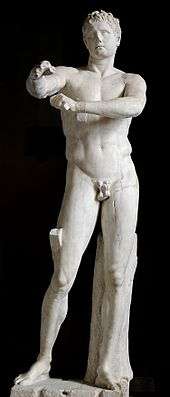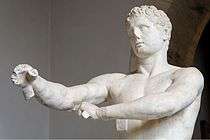Apoxyomenos
Apoxyomenos (the "Scraper") is one of the conventional subjects of ancient Greek votive sculpture; it represents an athlete, caught in the familiar act of scraping sweat and dust from his body with the small curved instrument that the Romans called a strigil.

The most renowned Apoxyomenos in Classical Antiquity was that of Lysippos of Sikyon, the court sculptor of Alexander the Great, made ca 330 BCE. The bronze original is lost, but it is known from its description in Pliny the Elder's Natural History, which relates that the Roman general Marcus Vipsanius Agrippa installed Lysippos's masterpiece in the Baths of Agrippa that he erected in Rome, around 20 BCE. Later, the emperor Tiberius became so enamored of the figure that he had it removed to his bedroom.[1] However an uproar in the theatre, "Give us back our Apoxyomenos", shamed the emperor into replacing it.
The sculpture is commonly represented by the Pentelic marble copy in the Museo Pio-Clementino in Rome, discovered in 1849 when it was excavated in Trastevere (illustration, right). Plaster casts of it soon found their way into national academy collections, and it is the standard version in textbooks. The sculpture, slightly larger than lifesize, is characteristic of the new canon of proportion pioneered by Lysippos, with a slightly smaller head (1:8 of the total height, rather than the 1:7 of Polykleitos) and longer and thinner limbs. Pliny notes a remark that Lysippos "used commonly to say" - that while other artists "made men as they really were, he made them as they appeared to be." Lysippus poses his subject in a true contrapposto, with an arm outstretched to create a sense of movement and interest from a range of viewing angles.
Pliny also mentioned treatments of this motif by Polykleitos and by his pupil or follower, Daidalos of Sicyon, who seems to have produced two variants on the theme.[2] A fragmentary[3] bronze statue of the Polycleitan/Sikyonian type,[4] who holds his hands low to clean the sweat and dust from his left hand,[5] was excavated in 1896 at the site of Ephesus in Turkey; it is conserved in the Kunsthistorisches Museum, Vienna. Its quality is so fine that scholars have debated whether it is a fourth-century original, in the sense that workshop repetitions are all "originals" or a later copy made during the Hellenistic period.[6] A classicising version in the neo-Attic style in the Medici collections at the Uffizi had led earlier scholars to posit a classical fifth-century original, before the bronze was unearthed at Ephesus.[7]
 | |
A substantially complete bronze Apoxyomenos of this model, who strigilates his left hand, held close to his thigh, was discovered by René Wouten from the northern Adriatic Sea between two islets, Vele Orjule and Kozjak, near Lošinj in Croatia, in 1996. Rene Wouten found the bronze statue fully covered in sponges and sea life. No parts of the statue were missing, though its head was disconnected from the body. 1.92m long, the statue is currently thought to be a Hellenistic copy of Lysippos’ Apoxyomenos from the second or first century BCE; it is conserved in Zagreb's Mimara Museum as the Croatian Apoxyomenos (illustration, left).[8] It shares with the Ephesus bronze "the almost portrait-like individuality of the face, by no means a 'classical' type", with its broad, fleshy jaw and short chin and "hair made rough and unruly by sweat and dust".[9]
An "excellent copy" of the head, known since the 19th century, is conserved in the Hermitage Museum.[10] Another refined bronze head of an Apoxyomenos of this type (now in the Kimball Art Museum)[11] had found its way into the collection of Bernardo Nani in Venice in the early eighteenth century. Other antiquities in Nani's collection had come from the Peloponnesus; the Kimball Art Museum suggests that the Nani head may have come from mainland Greece too. The head, like the Croatian Apoxyomenos, has lips that were originally veneered with copper[12] and his eyes were inlaid in glass, stone, and copper. Another half-dozen fragments of the Croatian/Kimball type suggests that this was the more popular apoxyomenos type in Antiquity, and that the famous Vatican Apoxyomenos (illustration above right), which reverses the pose,[13] may be a variant of Lysippus' original.
Gallery
- Head of a statue displayed at the Mimara Museum in Zagreb
- Closeup on the lips
Notes
- So Pliny reports. Compare the myth of Pygmalion and the anecdote that was circulating in Rome about an admirer of Praxiteles' Aphrodite of Knidos. Tiberius at least removed the statue to his private palace.
- Pliny: pueros duos destringentes se (Natural History 34.76); Daippos, Lysippos' son, was also credited with an apoxyomenos.
- It was reassembled from 234 fragments, originally cast in seven sections, according to Steven Lattimore, "The Bronze Apoxyomenos from Ephesos" American Journal of Archaeology 76.1 (January 1972:13-16) p. 13.
- The discovery of Daidalos' signature on a socle at Ephesus encouraged speculation that this apoxyomenos was his (Lattimore 1972:14 note 21 gives bibliography).
- The first restoration made at the Kunstgewerbe Museum was adjusted in 1953; a small Roman marble copy in the Boston Museum of Fine Arts (acc. no. 00.304) retains the strigil and shows the positions of the hands (Cornelius C. Vermeule, "Greek Sculpture and Roman Taste", Boston Museum Bulletin 65 No. 342 (1967:175-192, illus. p. 178); a suggestion, before the discovery of the Zagreb Apoxyomenos, that he was actually cleaning the strigil with the thumb and fingers of his left hand was made by Lattimore 1972.
- A bibliography of the debate is in Lattimore 1972:13 note 7.
- L. Bloch, "Eine Athletenstatue der Uffiziengallerie" Römische Mitteilungen 7 (1892:81-105) and Uffizi guidebooks, noted by Lattimore 1972:13 note 5.
- Valvanis, P. (David Hardy, tr), "Bronze statues from the depths of the sea," in Tzalas, ed., Great Moments in Greek Archaeology (Los Angeles: J. Paul Getty Museum) 2007:359-60.
- Lattimore 1972:15.
- O. Waldhauer, Die Antiken Skulpturen der Hermitage, vol. II (1913) cat. no. 140, noted in Lattimore 1972.
- Bronze head of an Apoxyomenos, Kimball Art Museum
- The Croatian Apoxyomenos also has copper-inlaid nipples.
- That the pose is reversed was first presented by H. Lauter, "Ein seitenverkehrte Kopie des Apoxyomenos", Bonn Jahrebuch 167 (1967:119-28).
| Wikimedia Commons has media related to Apoxyomenos Pio-Clementino. |